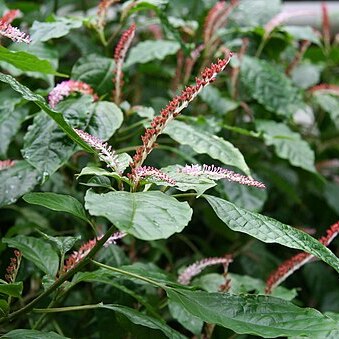Herbs or shrubs, rarely trees, erect, rarely scandent, mostly glabrous, rarely dioecious. Leaves simple, alternate, entire; stipules absent or tiny. Inflorescences terminal, axillary, or leaf-opposed, racemose, cymose, panicled, or spicate. Flowers small, bisexual or rarely unisexual, actinomorphic, rarely zygomorphic. Tepals 4 or 5, persistent, free or connate at base, equal or unequal, imbricate in bud, green or sometimes other colored. Stamens 4 to many, inserted on a fleshy disk; filaments usually persistent, free or slightly connate at base; anthers 2-loculed, dorsifixed, longitudinally dehiscent. Ovary superior, globose; carpels 1 to many, free or connate; ovule solitary in each carpel, basal, campylotropous. Styles persistent, short or absent, erect or curved, as many as carpels. Fruit fleshy, a berry or drupe, rarely a capsule. Seeds reniform or oblate, small; testa membranous or hard and fragile, smooth or wrinkly; embryo large, curved, surrounding copious mealy endosperm.
Herbs, subshrubs, shrubs, trees, or vines, annual or perennial. Leaves alternate, opposite, or appearing whorled; stipules minute or absent; blade pinnately veined, margins entire, often undulate. Inflorescences axillary, terminal, or leaf-opposed spikes, racemes, panicles, or compound dichasia; bract 1; bracteoles 2. Flowers hypogynous (epigynous in Agdestis), radially symmetric; sepals usually persistent, 4-8, imbricate in bud, often unequal; petals absent; stamens 4-30[-100], sometimes borne in 1-2 whorls on hypogynous disk; gynoecium 1-12[-18]-carpellate, the carpels connate or distinct; ovaries superior (inferior in Agdestis), 1-12[-18]-locular; placentation basal; ovules 1 per locule; styles distinct (connate in Agdestis). Fruits achenes, berries, or cypselas. Seeds: perisperm present; embryo curved. x = 9.
Herbs, shrubs or trees, mostly glabrous; hairs simple when present. Leaves alternate, simple, entire, exstipulate in Australia. Inflorescence a terminal, axillary or lateral raceme, bracteate. Flowers unisexual or bisexual, actinomorphic or zygomorphic. Perianth of 4 or 5 free, uniseriate, petaloid, imbricate tepals, equal or unequal, persistent. Stamens 3 to many, hypogynous, free; anthers 2-locular; stamens reduced to staminodes or absent in ♀ flowers. Ovary superior (rarely inferior outside Australia); carpels 1 to many, free or connate; styles as many as carpels, free; ovules 1 per carpel, basal. Fruit a nut, achene, drupe or berry. Seeds erect, with endosperm enclosed by large embryo.
Stamens (3) 4-many, 1–2-seriate, often inserted on more or less fleshy, annular disk, irregularly arranged or alternate to sepals; filaments slender, free or connate at base; anthers dorsi-or basifixed, dehiscing longitudinally
Ovary usually superior, composed of 1-many free or connate carpels; ovule basal, solitary in each carpel; styles absent or same number as carpels, free or united at base; stigmas linear or capitate
Fruit of 1-many, free or connate carpels, fleshy or dry, sometimes winged; seed subglobose, discoidal or reniform, often compressed; testa membranous or brittle; endosperm present
Stamens 3 to many, often inserted on a hypogynous disk; filaments free or slightly connate at the base; anthers 2-celled, cells parallel and dehiscing longitudinally
Ovary superior, composed of 1 or several carpels either free or variously connate; style almost none or short; ovule solitary in each carpel, basal
Flowers bracteate and bracteolate, hermaphrodite or unisexual (then usually with rudimentary aborted organs), usually actinomorphic
Flowers hermaphrodite or unisexual, actinomorphic or nearly so, hypogynous, in simple or compound terminal or axillary racemes
Leaves simple, alternate, entire, petiolate to sessile, crystals often visible especially on younger leaves
Seed erect, with the large embryo in the periphery and enclosing the endosperm
Inflorescences terminal or axillary, spicate, racemose or paniculate
Stipules absent (in the Flora Zambesiaca area), minute or thorny
Sepals free or some connate, imbricate, equal or unequal
Leaves alternate, entire; stipules absent or minute
Sepals 4–5, free or connate towards base, imbricate
Trees, shrubs or herbs, sometimes scrambling
Fruit of 1 or many carpels, fleshy or dry
Perianth simple, herbaceous or coriaceous
Herbs, shrubs or trees
Petals absent
Petals absent


